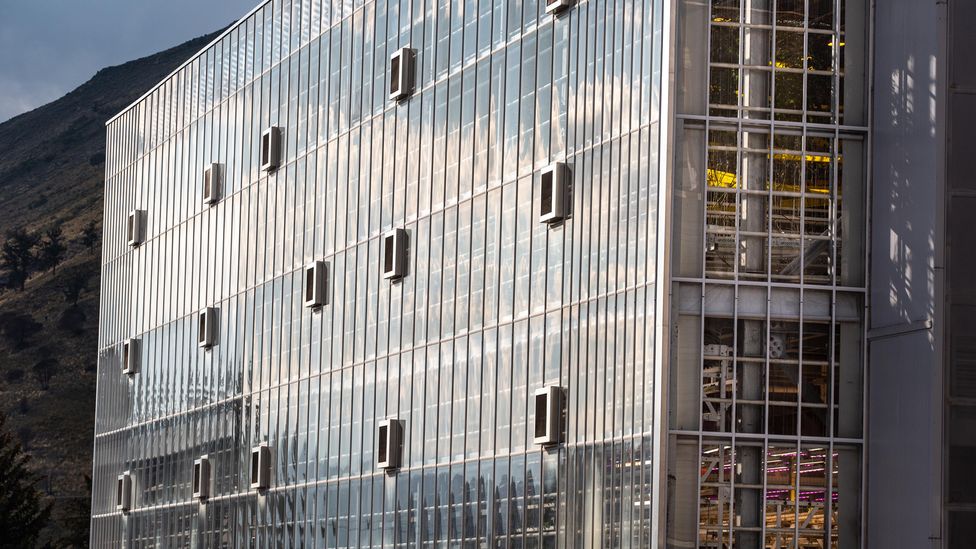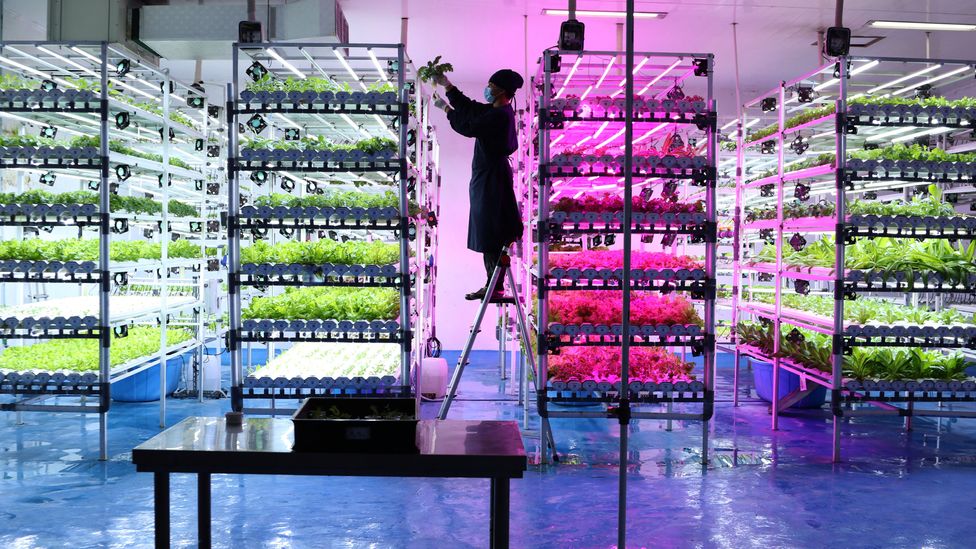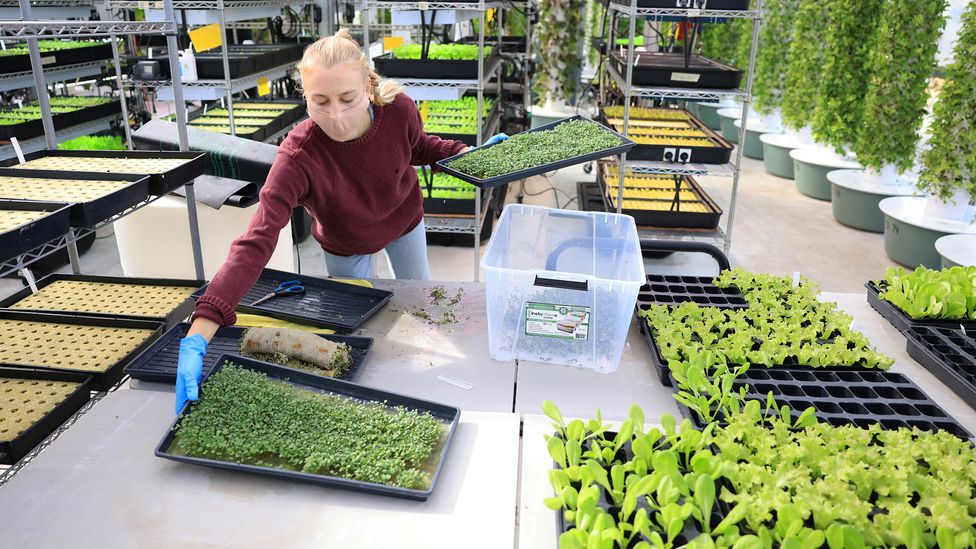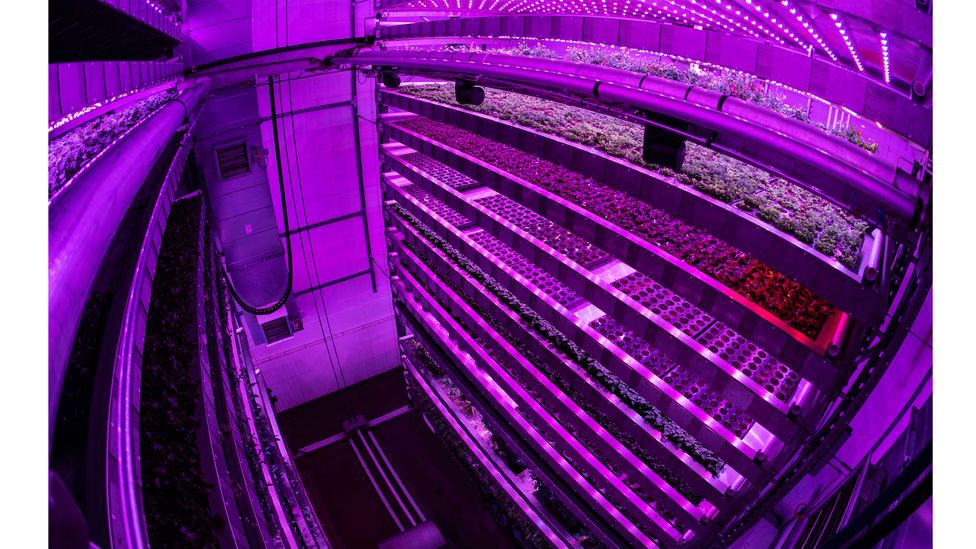Vertical farming guarantees a future by which our meals is grown in pockets of areas in our cities and beneath our ft. However how far can it actually go?
When the Pasona City Farm opened within the nine-storey workplace of a Japanese recruitment firm in 2010, it promised a future by which meals was grown inside ft of the individuals who would eat it.
Tomatoes hung down from meeting-room mild fittings, a rice paddy crammed a big convention house, and mushrooms grew in drawers hidden discreetly below benches. The workplace seemed extra like a museum of farming than a place of job.
Whereas the fashionable idea of vertical farming – rising meals in trays or pipes stacked on prime of each other like a large plant lasagne – dates from across the Nineties, it might be argued that farmers have sought methods to develop extra in much less house and with much less soil for hundreds of years. Step-over fruit bushes – normally apple and pear bushes – are grown as little as 1ft (30cm) off the bottom and unfold laterally to fill skinny strips of house in allotments and orchards. The step-over method is predicated on espalier coaching, which may date again to Historical Roman grape cultivation.
What would a world the place all our meals is grown in such farms appear to be?
However vertical farming within the trendy sense is now spreading quickly. One instance is the vertically farmed strawberry model Oishii, based mostly in New Jersey. In 2021, a punnet of its coveted Japanese Omakase strawberries retailed for $50 (£44) in a high-end New York grocery store. For some, this was proof that with time vertical farming may rival and finally exceed conventional farming for high quality. For others, the outlandish worth highlighted the massive problem to make vertical farms commercially viable.
Whereas the know-how reveals a lot promise, the prices in each cash and power are nonetheless excessive. This implies leafy salads, smaller greens and fruits comparable to tomatoes and strawberries – excessive worth crops which develop shortly – are in regards to the restrict of what’s at present accessible commercially from vertical farms.
However the place precisely is the restrict of what we are able to truly develop in a vertical farm? And if we did discover a technique to overcome the issues of price and power use, what would a world the place all our meals is grown in such farms appear to be? May we ever transfer to fully soil-free farming?
Pasona Group’s city farm in Tokyo, Japan, allowed workplace staff to reap their very own meals at work (Credit score: Andia/Getty Photos)
Farming upwards
There is no such thing as a strict definition of what a vertical farm is, however they sometimes include shallow trays stacked inside a constructing, lit with LED lighting at every stage. Many vertical farms don’t have any home windows and some are even constructed underground.
These sorts of farms should provide the whole lot – water, vitamins, daylight and probably pollinators and pest management too. Others could be inbuilt large greenhouses – profiting from the Solar’s mild and warmth, however nonetheless controlling different inputs like water.
Whereas generally soil is used, more and more vertical farms use hydroponic or aeroponic techniques, the place water (for hydroponics) or water vapour (for aeroponics) infused with vitamins is circulated straight across the roots of the plant.
“The water effectivity and nutrient effectivity is admittedly fairly excessive in hydroponics and aeroponics as a result of the roots are capable of get these vitamins and water in rather a lot faster,” says Laura Vickers, a plant biologist and head of the City Farming Group at Harper Adams College within the UK. “There’s no natural matter, there’s nothing else for the plant to compete with or to extract the water from.”
This implies utilizing vertical farms can significantly scale back each the water and fertilisers wanted to develop meals. In the meantime, the closed-off, managed setting of vertical farms may also help to cease pests getting in – in flip probably lowering the necessity for pesticides.
The know-how may enable crops to develop in places the place standard farming shouldn’t be potential. Astronauts on the Worldwide Area Station, for instance, are rising their very own meals in soilless techniques below LED lights – with cabbage, mizuna mustard, lettuce and kale among the many crops on the menu.
Extra usually, although, the small quantity of land wanted for vertical farms means meals might be grown close to to cities, says Natalia Falagan, an engineer from Cranfield College within the UK, which may give large advantages. Shorter provide chains may enhance each meals safety and the standard of meals, because the sooner meals reaches us, the much less its vitamins deteriorate and the much less unseen toxins, comparable to mycotoxins, develop. It could additionally lead to far fewer meals miles than many imported options and assist to ensure the provenance of crops, she says, whereas additionally lowering the burden on pure assets like soil, water and the ambiance. What’s extra, with superior plant science, the crops might be engineered to be more healthy and tastier, she provides.
The city Vertical Harvest in Jackson, Wyoming grows lettuce, micro greens and tomatoes in a big vertical hydroponic farm (Credit score: George Rose/Getty Photos)
Having vertical farms within the midst of cities may additionally assist to make us extra conscious of how our meals is produced, says Falagan. Pasona City Farm, for instance, wasn’t only for present – it allowed workplace staff to reap their very own meals at work, which the corporate hoped would enhance each their psychological and bodily well being. Falagan says that having a better reference to the place our meals comes from may encourage shoppers to be extra cautious with meals waste, too. “If individuals understand how a lot goes into producing our meals,” she says, “then possibly they are going to assume twice about throwing it out.”
Most vertical farms at present focus on low-biomass crops – issues like herbs, salads and small vegatables and fruits which weigh much less per portion – as a result of there’s a larger yield for the quantity of warmth, mild and water that must be provided. Additionally they have quick life cycles, so make most use of house, says Vickers. A leafy inexperienced will develop shortly and be prepared to reap in days or weeks, whereas a pumpkin would take months to develop and must remedy in daylight.
Salads and herbs don’t have to flower and be fertilised, which provides them one other benefit over different crops on the subject of vertical farming
A meta-analysis of city farming in quite a lot of settings throughout 53 nations discovered lettuces, kale and broccoli have been significantly suited to vertical farms. Crops like spinach might be grown from seed to reap in 30 days, that means a vertical farmer may have 12 harvests from the identical tray every year. What’s extra, if the farmer have been to stagger planting their crop from one row of trays to the subsequent, they might have an nearly steady provide of meals all yr spherical from their farm – one thing a standard farmer can solely dream of.
Misplaced bees
Salads and herbs don’t have to flower and be fertilised, which provides them one other benefit over different crops on the subject of vertical farming. Most vegatables and fruits do require pollination, and the place it’s wanted for vertical farms it must be performed artificially at a price.
Farmers already usually depend on industrial bees to encourage pollination and maximise fruiting for each indoor and out of doors farming. For instance, the almond business, of which 85% is predicated in California’s Central Valley, will depend on billions of honey bees which can be shipped tens of 1000’s of miles to and from Florida to pollinate the almond blossoms every year. The hives are introduced in on vans and the bees are launched into every grove earlier than being moved on to the subsequent farm. Within the UK, strawberries grown in polytunnels are additionally pollinated with industrial honey bees – although, curiously, pollination by wild bees ends in bigger fruits.
Plant petals mirror UV mild to draw bees, as illustrated on this ultraviolet-induced seen fluorescence picture of Gazania flowers (Credit score: Calvin Jennings/Getty Photos)
Business bee pollination has already been utilized to indoor farming, says Vickers. However utilizing bees in an indoor setting poses an issue – the bogus lights could make it tough for bees to navigate.
To people, indoor farms usually seem illuminated in neon pinks and purples. It’s because vegetation develop finest when uncovered to largely blue and purple wavelength mild, which to us appears to be like pink or purple from a distance. However bee imaginative and prescient could be very completely different from ours. They can not see the color purple, however can see within the ultraviolet (UV) spectrum, which people can not. Outside, plant petals mirror UV to assist bees navigate to them. This places bees at a definite drawback in vertical farms, the place UV is at present not used. Including it may make indoor farms much more costly, particularly contemplating this similar mild is totally free for out of doors farmers.
“We take into consideration vertical farming from the plant’s perspective,” says Vickers. “And we don’t take into consideration what the bee sees and the way it finds the vegetation. The bees battle to navigate below the present LEDs.”
Vertical grains
Different crops, comparable to cereals, are pollinated by wind, which might be simply replicated by making a draught inside the vertical farm, says Vickers. However whereas there are some examples of vertical farms experimenting with rising cereals, it’s nonetheless uncommon. “Barley or wheat, which takes many months to develop, are usually not at present price efficient,” says Vickers.
The explanation for this excessive price is the largest barrier to the widespread use of vertical farms – they require large quantities of power and infrastructure. Whereas with the ability to develop crops year-round will increase the effectivity of a vertical farm, the problem these farms face is to maintain power use down when the choice – rising exterior – comes with free daylight and rainwater. This reliance on power may make vertical farms extremely susceptible to unstable power costs.
In lots of locations, the electrical energy used to energy vertical farms additionally nonetheless comes from fossil fuels, that means total greenhouse gasoline emissions might be far increased than for open-field farming. Switching to renewable power is the plain means to scale back this carbon footprint, though, since most renewables themselves require land, this could scale back the land-saving advantages of indoor farming considerably.
Farmers are likely to illuminated vegetable crops contained in the Sentral Farm constructing, in West Java, Indonesia (Credit score: Dasril Roszandi/Getty Photos)
Botanically talking, barley or wheat are fairly potential inside a vertical farming system as a result of their quick root construction, says Vickers, which is necessary for rising them in trays.
And whereas it’s unlikely we’ll ever develop all our grains in vertical farms, it may nonetheless show to be helpful in some conditions. In 2020, agricultural scientists from a number of US universities revealed an article arguing vertical farming may someday play a task in hedging towards future surprising provide chain disruptions. As the continued warfare in Ukraine has highlighted the world’s dependence on cereals from jap Europe and sparked a seek for various sources, it might be a proposal value contemplating.
Indoor orchards
However Vickers says that it’s truly woody crops, comparable to fruit bushes, which might actually take a look at the bounds of what’s potential to develop in a vertical farm, not least as a result of they might require important assist with out soil. Botanically, nonetheless, there isn’t any purpose that indoor orchards are usually not potential, she says.
“A tree already is a form of vertical farm,” says Mark Horler, chair of the UK City AgriTech, which represents the nation’s indoor agriculture neighborhood. “Timber take water with vitamins in it, and distribute it throughout a collection of layers that then develop leaves and fruits. As ever, nature was there first.”
Together with Kerstin Schreiber, a geographer at McGill College, Horler is co-founder of the Soya Challenge, an initiative set as much as promote the advantages of vertical farming. He’s at present investigating the potential of rising willow saplings indoors in vertical farms to hurry up their progress earlier than being planted exterior, and so to hopefully improve their survival charge. “The speed of failure in reforestation and afforestation initiatives is phenomenal,” he says, citing how susceptible saplings are to the weather when they’re very small (in a single examine, 83% of replanted bushes died inside 10 years). “Solely a very small proportion make it to the ultimate grade.”
But when given the top begin, Horler hopes the saplings will stand a greater probability. And he’s not the one one seeking to vertical farming to provide bushes a lift. Zoe M Harris, an environmental scientist from the College of Surrey within the UK, is main an identical challenge which has not too long ago been awarded £4m ($4.8m) in UK authorities funding, whereas a challenge propagating apple tree saplings in aeroponic techniques began in England final yr. Early trials of a vertical farm challenge in Scotland managed to develop tree seedlings six instances sooner than is typical in conventional out of doors sowing.
Vertical farms – such because the Altius farm in Denver, Colorado pictured right here – is now spreading quickly (Credit score: Kevin Mohatt/Alamy)
Horler says he sees no purpose why bushes couldn’t be grown completely indoors for meals. A vertical orchard may look a bit completely different to those we’re used to seeing, nonetheless. “What you’d need is a collection of skinny saplings that fruit actually usually, slightly than ready for one tree which produces all its fruit ,” says Horler. Most apple bushes are already dwarf varieties of untamed species, he says, so dwarfing them additional isn’t out of the query.
In Asia, dwarf mango bushes are being trialled as a result of the smaller selection helps harvesters decide their fruits. And in 2019, a collective of researchers have been capable of produce a tomato plant that, in Horler’s phrases, “nearly appears to be like like a bunch of grapes” – the tiny plant was lined in ripe tomatoes.
Plant scientists would wish to unravel some long-standing issues earlier than all our meals might be grown vertically, says Laura Vickers
Dwarfing crops makes them extra appropriate for vertical farming, agrees Vickers. However the selection that performs finest open air gained’t essentially be the range that performs finest inside a managed setting, she provides, so dwarfing a longtime selection won’t at all times work. For instance, sure varieties may carry out finest open air as a result of they’re hardy to temperature variations or illnesses, which could not be such necessary elements indoors.
Vertically farmed bushes and crops that take longer to mature may additionally be difficult to maintain disease-free, says Vickers. Between harvests of herbs and salads, a vertical farmer can sterilise trays earlier than the subsequent crop is planted. Nonetheless, mango bushes, for instance, can take years to mature, by which time mould and micro organism can thrive.
“The illness has the time of its life as a result of – similar to the plant – it has the proper setting, good temperature, good quantity of oxygen, good vitamins and entry to all these pretty vegetation as nicely,” says Vickers.
If circumstances are ultimate, nonetheless, Horler says a vertically farmed tree may be capable of truly make investments extra in its fruits. “A plant will commit its assets to what it thinks it may possibly do finest,” he says. “If it’s being examined, then it is going to put extra effort into defending itself from tougher circumstances…[But] if it’s in ultimate circumstances and having a simple life, then it is going to develop plenty of leaves and flowers and fruit, it gained’t develop these large metres-long root techniques.”
Pink mild illuminates a vertical farm in Invergowrie, Scotland. Crops develop finest when uncovered to largely blue and purple wavelength mild (Credit score: Andy Buchanan/Getty Photos)
There is no such thing as a botanical purpose, then, why all our meals couldn’t be grown vertically, says Vickers. And, in fact, metropolis planners, renewable power suppliers and farmers themselves would all have an enormous half to play.
Supply: BBC
